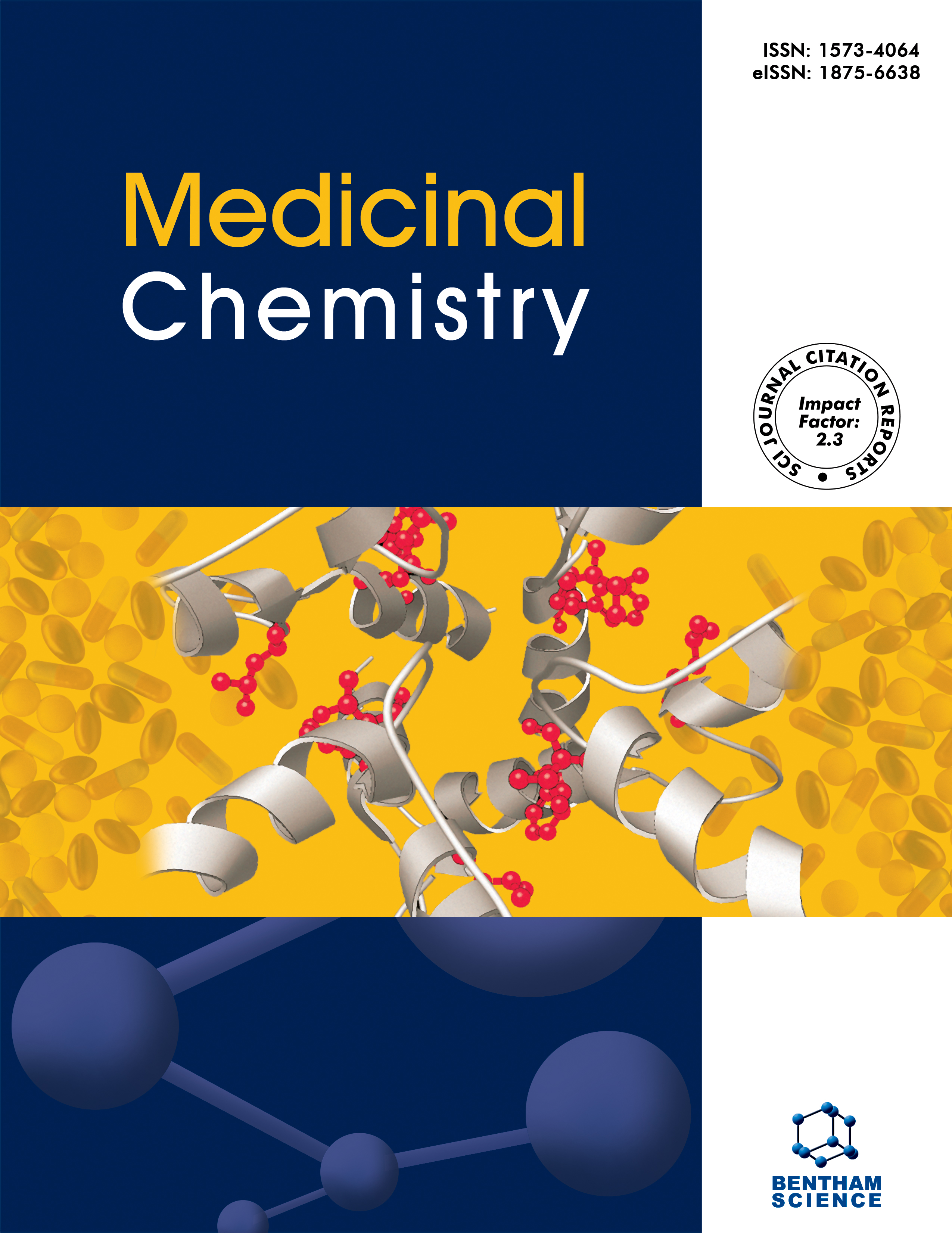- Home
- A-Z Publications
- Medicinal Chemistry
- Previous Issues
- Volume 1, Issue 3, 2005
Medicinal Chemistry - Volume 1, Issue 3, 2005
Volume 1, Issue 3, 2005
-
-
Application of Bioinformatics in Search for Cleavable Peptides of SARSCoV Mpro and Chemical Modification of Octapeptides
More LessAuthors: Qishi Du, Shuqing Wang, Zhiqin Jiang, Weina Gao, Yun Li, Dongqing Wei and Kuo-Chen ChouAccording to the “distorted key” theory as elaborated in a review article years ago (Chou, K.C.: Analytical Biochemistry, 1996, 233, 1-14), the knowledge of the cleavable peptides by SARS-CoV Mpro (severe acute respiratory syndrome coronavirus main proteinase) can provide very useful insights on developing drugs against SARS. In view of this, the softwares, ZCURVE_CoV 1.0 and ZCURVE_CoV 2.0 (http: / / tubic.tju.edu.cn Read More
-
-
-
Effects of Introducing Silicon Isosteres in COX-2 Inhibitors: A Preliminary In Silico Evaluation
More LessSince the discovery that the anti-inflammatory effects of cyclooxygenase (prostaglandin endoperoxide H2 synthetase; COX) inhibitors were dependent on their selectivity for the inducible COX-2 isoform over the constitutive COX-1, many efforts have been devoted towards the design of compounds displaying improved COX-2 selectivity. Classical bioisosteres such as CH-CF and CH2-S/O substitutions have been extensively Read More
-
-
-
Investigation of Bioisosteric Effects on the Interaction of Substrates/ Inhibitors with the Methionyl-tRNA Synthetase from Escherichia coli
More LessAuthors: M. D. Vaughan, P. B. Sampson, E. Daub and J. F. HonekAminoacyl-tRNA synthetases catalyze the stepwise coupling of specific amino acid substrates to their cognate tRNAs. The first intermediate formed in this process is the aminoacyl-adenylate, which then subsequently reacts with the 3¢-terminus of the cognate tRNA to transfer the amino acid to the tRNA. This overall reaction is critical for protein biosynthesis and is quintessential to the viability of all organisms. Therefore, the sele Read More
-
-
-
Variously Substituted (Phosphonoacetamido)Oxy Analogues of Geranylgeranyl Diphosphate (GGdP) as GGdP-transferase (GGTase) Inhibitors and Antiproliferative Agents
More LessAberrant signalling through the pathways of small GTP-binding proteins, belonging to the Ras superfamily (Ras, Rho, Rac, Cdc42 etc.), occurs in several types of cancer, where mutated Ras accumulates in its GTP-bound active form and causes uncontrolled cell proliferation. For these reasons, molecules able to target the Ras pathway in any of its stages are potentially useful in anti-cancer therapies. Inhibition of farnesyl-protein Read More
-
-
-
Synthesis and Biological Evaluation of 2-, 3-, and 4-Acylaminocinnamyl-Nhydroxyamides as Novel Synthetic HDAC Inhibitors
More LessA new series of 2-, 3-, and 4-acylaminocinnamyl-N-hydroxyamides 1-3 have been prepared, and their anti- HDAC (against maize HD2, HD1-B, and HD1-A enzymes) activities have been assessed. Cinnamyl-hydroxyamides bearing acylamino substituents at the C2 position of the benzene ring (compounds 1a-g) showed very low HDAC inhibiting activities, with IC50 values in the high micromolar range. By shifting the same acyla Read More
-
-
-
Synthesis and Evaluation of a Novel Gene Reporter Molecule: Detection of b-galactosidase Activity Using 19F NMR of a Fluorinated Vitamin B6 Conjugate+
More LessAuthors: Jianxin Yu, Zhenyi Ma, Yingming Li, Kenneth S. Koeneman, Li Liu and Ralph P. MasonGene therapy has emerged as a promising strategy for treatment of various diseases. However, widespread implementation is hampered by difficulties in assessing the success of transfection, in particular, the spatial extent of expression in the target tissue and the longevity of expression. Thus, the development of non-invasive reporter techniques based on appropriate molecules and imaging modalities may help to assay g Read More
-
-
-
Discovery of HIV-1 Integrase Inhibitors through a Novel Combination of Ligand and Structure-based Drug Design
More LessAuthors: A. Brigo, G. I. Mustata, J. M. Briggs and S. MoroOver the past 10 years, classical computer-aided molecular design methods have not been frequently applied for the discovery of novel HIV-1 integrase (IN) inhibitors, due to the intrinsic challenges that this enzyme presents. Therefore, a novel approach that combines the chemical information of known integrase inhibitors with the enzyme's detailed 3D structure in a stepwise fashion is proposed: (I) use of a pharmac Read More
-
-
-
Aminopyrimidinimino Isatin Analogues: Design and Synthesis of Novel Non- Nucleoside HIV-1 Reverse Transcriptase Inhibitors with Broad- Spectrum Anti-Microbial Properties
More LessAuthors: Dharmarajan Sriram, Tanushree R. Bal and Perumal YogeeswariHIV is the most significant risk factor for many opportunistic infections like tuberculosis, bacterial infections etc. In this paper, we designed aminopyrimidinimino isatin lead compound as a novel non-nucleoside reverse transcriptase inhibitor with broad-spectrum chemotherapeutic properties for the effective treatment of AIDS and AIDS-related opportunistic infections. Compound 1-ethyl-6-fluoro-1,4-dihydro-4-oxo-7[ Read More
-
-
-
Evaluation of Hyperforin Analogues for Inhibition of 5-lipoxygenase
More LessAuthors: Christian Feißt, Dana Albert, Luisella Verotta and Oliver WerzThe acylphloroglucinol hyperforin, a constituent of the herb Hypericum perforatum (St. John's wort), was recently identified as potent and direct inhibitor of 5-lipoxygenase (5-LO), the key enzyme in the biosynthesis of proinflammatory leukotrienes. In this study, naturally occurring analogues of hyperforin, isolated from H. perforatum, as well as a series of synthetic derivatives obtained by chemical modification of hyperforin b Read More
-
-
-
Protein Phosphorylation and Signal Transduction Modulation: Chemistry Perspectives for Small-Molecule Drug Discovery
More LessProtein phosphorylation has been exploited by Nature in profound ways to control various aspects of cell proliferation, differentiation, metabolism, survival, motility and gene transcription. Cellular signal transduction pathways involve protein kinases, protein phosphatases, and phosphoprotein-interacting domain (e.g., SH2, PTB, WW, FHA, 14-3- 3) containing cellular proteins to provide multidimensional, dynamic and reversible r Read More
-
Volumes & issues
-
Volume 21 (2025)
-
Volume 20 (2024)
-
Volume 19 (2023)
-
Volume 18 (2022)
-
Volume 17 (2021)
-
Volume 16 (2020)
-
Volume 15 (2019)
-
Volume 14 (2018)
-
Volume 13 (2017)
-
Volume 12 (2016)
-
Volume 11 (2015)
-
Volume 10 (2014)
-
Volume 9 (2013)
-
Volume 8 (2012)
-
Volume 7 (2011)
-
Volume 6 (2010)
-
Volume 5 (2009)
-
Volume 4 (2008)
-
Volume 3 (2007)
-
Volume 2 (2006)
-
Volume 1 (2005)
Most Read This Month
Article
content/journals/mc
Journal
10
5
false
en


